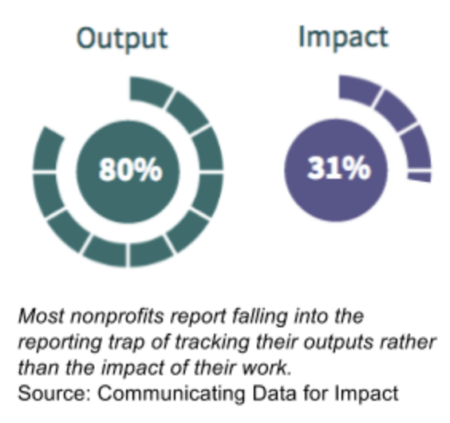Blog • Insights
To Measure Success at Your Mission-Driven Organization, Look at Impact, Not Just Activities
Nonprofit and government agencies work every day to communicate important messages, engage with key audiences, and motivate them to action. It’s easy to recite a list of all the things you and your team completed last quarters (e.g., published two white papers with thousands of downloads; authored eight blog posts; live-tweeted at three events; sent out 10,000 emails within 1,300 click-throughs; issued a press release). However, this can lead to falling into the reporting trap.
Instead of just enumerating the activities you completed, measure the impact of your work. You can do that by providing metrics that tell the story of how you are moving your mission forward — which may go beyond how many times someone clicked a link or liked a post.
A few years ago, while working on a digital communications strategy for a major foundation, it was time to brief the new communications director on the project and the plan we developed.
The client walked into the meeting with one very important question: “So what?”
My team and I had been working with his organization for the past year. During that time, we re-launched the foundation’s website, developed a comprehensive social media engagement plan, set up an email outreach schedule, and put in place an analytics & reporting strategy that encompassed the full spectrum of the foundation’s online communications. All in all, a considerable amount of time, effort, and money had been poured into the plan.
To answer the client, I needed to ensure that I was speaking the same language as leadership and framed success in terms of their organization’s goals, especially when it came to how we made an impact.
Outputs vs Impact in Mission-Driven Organization Reporting
There is a clear difference between “outputs” and “impact” and how we measure them. Outputs are the tangible results of a task or activity. Say you have put time into your digital communications channels, the following may be some examples of outputs vs. impact:

Outputs: Published new reports, created an improved page on donations, added technical capacity to make donations easier
Impacts: 150% increase in donations to the organization that increases the capacity to deliver high-quality programming to key audiences, in turn improving their quality of life
The key is in determining how you plan to measure and report on your impact and outlining that as early as possible when developing your strategy.
Read More: Nonprofit Digital KPIs That Matter: Your Guide to Creating a Mission-Aligned Measurement Plan
How to Develop an Impact Measurement Plan
To ensure you and your team are able to communicate success in terms of moving your mission forward, take some time to reflect on the following questions:
The Big Picture
What is your organization trying to achieve through its mission?
You must understand the root of what your organization is trying to achieve and how it collectively defines success before you can demonstrate progress toward it.
Target Audiences
Is your work or output reaching the right people to help your organization achieve its mission?
When it comes to achieving your mission, not all people have equal value. It’s important that you focus your reporting specifically on those who can make a difference.
Output Metrics
What outputs are being produced?
It’s imperative that you know how each work product (e.g., event, report, blog, etc.) supports your mission. In cases where this is not clear, revisit whether or not these products are worth continuing as they are.
Engagement Metrics
Is the target audience using or engaging with your output in a constructive way? Did they take constructive action?
Simply distributing materials to target audiences does not tell us if they actually read, used, or acted on them. Capture their engagement through their actual actions, for example, the time they spent or the depth they scrolled within your website, if they registered and/or attended an event if they signed a petition, etc.
Impact Metrics
What methods can you use to monitor progress toward your mission?
By reflecting back on your organizational goals, conduct a survey of your target audiences to see if you’ve shifted their mindsets or motivated them for action. Additionally, you can leverage existing surveys, polls, ratings or studies conducted by others to monitor change over time.
Measuring Influence
What were your organization’s contributions to an overall outcome or impact?
You don’t work in a vacuum, and it’s important to acknowledge your role, and the role of others, in an outcome. As an example, a great model that a large nonprofit we’ve worked with uses a three-tiered approach to evaluate its role in producing the measured impacts:
- Decisive: The weight of evidence suggests the outcome would not have been achieved without the program’s efforts.
- Important: Multiple factors contributed to the outcome and we played a substantive role.
- Inconsequential: The program played little or no part in the outcome and would have occurred without its involvement.
Bringing it Together to Demonstrate Your Organization’s Impact
Assembling a holistic digital strategy and quantifying its impact on your mission isn’t easy. There is no one-size-fits-all approach, but there are best practices for both data collection and reporting.
It takes a deep understanding of your organization’s mission, what outcomes you are looking to achieve, and how you are working to achieve them in order to develop methods to monitor progress. We’ve worked with many organizations to do just this, so if you are new to business intelligence, or are looking for ways to tie your digital strategy and data to your organizational mission, we’re here to help.
For more on focusing on measuring actionable data check out Looking Past Vanity Metrics to Actionable Analytics.